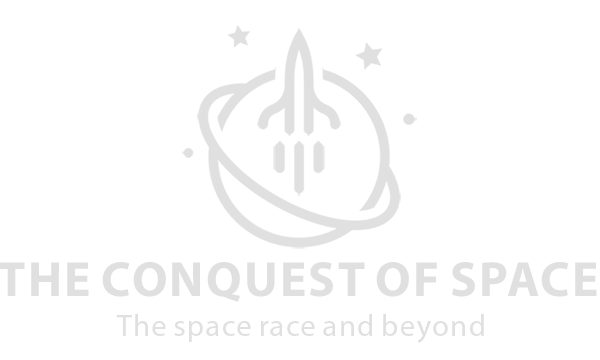A Near Miss: When Three Apollo Astronauts Were Nearly Killed on Reentry
The Apollo-Soyuz Test Project
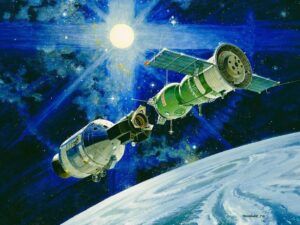 On July 24, 1975, six years to the day after the Apollo 11 crew returned safely to Earth, reaching the zenith of America’s space race program, the Apollo-Soyuz Test Project crew returned to Earth. It was to be the last hurrah of the Apollo era. The last flight of the hardware that had put human footprints on the moon. The mission had been sold as a cooperation between the world’s two superpowers and the only space powers. It was part foreign policy, part American publicity to showcase the diplomatic prowess of President Richard Nixon, but very little about accomplishing anything significant in space. The price paid would be high. A final space station mission to accomplish real science would need to be scrapped. The second Skylab space station would be destined for display as a museum artifact, while three unused Saturn V rockets would be left to rot until being salvaged and restored for display. The ASTP mission itself would end in near tragedy for the three American astronauts.
On July 24, 1975, six years to the day after the Apollo 11 crew returned safely to Earth, reaching the zenith of America’s space race program, the Apollo-Soyuz Test Project crew returned to Earth. It was to be the last hurrah of the Apollo era. The last flight of the hardware that had put human footprints on the moon. The mission had been sold as a cooperation between the world’s two superpowers and the only space powers. It was part foreign policy, part American publicity to showcase the diplomatic prowess of President Richard Nixon, but very little about accomplishing anything significant in space. The price paid would be high. A final space station mission to accomplish real science would need to be scrapped. The second Skylab space station would be destined for display as a museum artifact, while three unused Saturn V rockets would be left to rot until being salvaged and restored for display. The ASTP mission itself would end in near tragedy for the three American astronauts.
The Foundation of Cooperation in Space
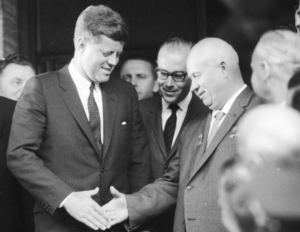 Before the Apollo-Soyuz Test Project, the United States made several attempts to engage the Soviets in a joint space effort. President John F. Kennedy was the first to propose a combining of U.S. and Soviet resources. Kennedy’s core focus was defusing tensions between the U.S. and the Soviets by working together on a moon landing. His message to Nikita Khrushchev initially laid out specifics on what cooperation would entail. Khrushchev had initially responded positively but then added that “cooperation without disarmament” as a precursor would severely limit the extent to which joint sharing of information or joint missions could occur.
Before the Apollo-Soyuz Test Project, the United States made several attempts to engage the Soviets in a joint space effort. President John F. Kennedy was the first to propose a combining of U.S. and Soviet resources. Kennedy’s core focus was defusing tensions between the U.S. and the Soviets by working together on a moon landing. His message to Nikita Khrushchev initially laid out specifics on what cooperation would entail. Khrushchev had initially responded positively but then added that “cooperation without disarmament” as a precursor would severely limit the extent to which joint sharing of information or joint missions could occur.
Once again, Kennedy tried at a speech to the United Nations shortly before his death, asking for cooperation between nations on space endeavors. Still, by the time of Kennedy’s second speech, the race between the U.S. and the Soviets was too far along to reset each nation’s strategies. The assassination of John F. Kennedy shortly after the U.N. speech ended any chance for cooperation as fulfilling Kennedy’s moon challenge would be accomplished by the U.S. alone in honor of the fallen President.
Nixon Ascends and America’s Space Program Descends
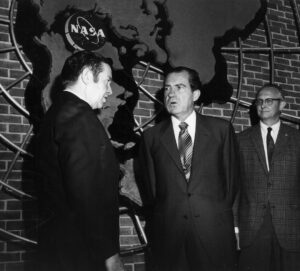 With Richard Nixon’s election in November of 1968, the course was changing. Over its young history, the space program was being driven by political concerns and ambitions rather than technical achievements. For all its significance, the technological achievements were merely a means to an end for dominance on the world’s political stage. The Nixon view towards space would be no different. Nixon had fought for the creation of NASA as Eisenhower’s Vice President. Now, NASA would be his political pawn in a chess game of détente with the Soviets. Early in 1969, and at Nixon’s direction, overtures were made to the Soviets to engage in discussions about a joint space effort. With the moon landing not yet achieved but within sight, the Soviets were in a difficult position that made accepting such overtures a public acceptance of defeat. Ironically, that same year the movie “Marooned” would be released. The film depicted three American astronauts trapped in an Apollo-like capsule after the service module engine failed to ignite. The movie ends with a Soviet spacecraft changing course and reaching the astronauts and providing assistance until help arrived. That very concept was an original tenet of the Kennedy-Khrushchev proposal back in the early sixties. Marooned was the first movie portrayal of the U.S. and Soviets cooperating in space when the rivalry and hard feelings were at an all-time high. It would take persistence by Nixon’s lieutenants and a more receptive Soviet Academy of Science that would finally convince the Soviets to undertake a joint mission and make cooperation in space a reality.
With Richard Nixon’s election in November of 1968, the course was changing. Over its young history, the space program was being driven by political concerns and ambitions rather than technical achievements. For all its significance, the technological achievements were merely a means to an end for dominance on the world’s political stage. The Nixon view towards space would be no different. Nixon had fought for the creation of NASA as Eisenhower’s Vice President. Now, NASA would be his political pawn in a chess game of détente with the Soviets. Early in 1969, and at Nixon’s direction, overtures were made to the Soviets to engage in discussions about a joint space effort. With the moon landing not yet achieved but within sight, the Soviets were in a difficult position that made accepting such overtures a public acceptance of defeat. Ironically, that same year the movie “Marooned” would be released. The film depicted three American astronauts trapped in an Apollo-like capsule after the service module engine failed to ignite. The movie ends with a Soviet spacecraft changing course and reaching the astronauts and providing assistance until help arrived. That very concept was an original tenet of the Kennedy-Khrushchev proposal back in the early sixties. Marooned was the first movie portrayal of the U.S. and Soviets cooperating in space when the rivalry and hard feelings were at an all-time high. It would take persistence by Nixon’s lieutenants and a more receptive Soviet Academy of Science that would finally convince the Soviets to undertake a joint mission and make cooperation in space a reality.
The proposal for a joint effort came attached to other cooperation points, such as providing the Soviets with lunar rock samples and exchanging weather satellite data. The political deal-making by the White House would get NASA caught in what would be the first of many political and budget dramas that would playout for the next forty-years following the moon landing. The Nixon White House had put a stranglehold on the NASA budget, and no matter what the directive or mission, NASA could not exceed its budget number. At one point in 1970, Nixon had publicly stated that manned spaceflight by the U.S. would come to an end following Apollo 17 and that unmanned missions were to be the preferred choice. Nixon had already canceled Apollo 18, 19, and 20. NASA had worked furiously to save manned spaceflight and won approval to continue on the basis that their new vehicle, the space shuttle, would be the cheapest route to space. Nixon finally agreed that the shuttle was less expensive than any other solution to carry payloads human or otherwise into space.
Flying on Borrowed Time
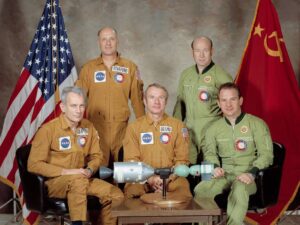 There were other problems with the continuation of manned space flight in the interim until the new shuttle came on board. NASA was using leftover Apollo hardware for Skylab to keep America in space. NASA had built two Skylab space stations. Skylab I had flown successfully after some initial glitches and was inhabited by three separate crews. NASA’s post-lunar/pre-shuttle plan for space came down to launching a second Skylab or doing the ASTP project. With budget issues looming large over NASA, a second Skylab was out of the question. While the hardware had already been bought and paid for, the expense of operating Skylab would delay the shuttle development. NASA’s budget was fixed and well below the Apollo years. In the spirit of détente with the Soviets, Richard Nixon would get the first mission in space between once rival nations. For the Soviets, there was another reason to cooperate with their former rival. Despite their success with the Salyut I space station, their first attempt at docking failed. The Soviets had a string of prior flights where two, and on one occasion, three spacecraft executed a rendezvous but did not dock. It seemed the Soviets had a problem docking two manned spacecraft. The partnership with the U.S. could be a direct benefit to their program.
There were other problems with the continuation of manned space flight in the interim until the new shuttle came on board. NASA was using leftover Apollo hardware for Skylab to keep America in space. NASA had built two Skylab space stations. Skylab I had flown successfully after some initial glitches and was inhabited by three separate crews. NASA’s post-lunar/pre-shuttle plan for space came down to launching a second Skylab or doing the ASTP project. With budget issues looming large over NASA, a second Skylab was out of the question. While the hardware had already been bought and paid for, the expense of operating Skylab would delay the shuttle development. NASA’s budget was fixed and well below the Apollo years. In the spirit of détente with the Soviets, Richard Nixon would get the first mission in space between once rival nations. For the Soviets, there was another reason to cooperate with their former rival. Despite their success with the Salyut I space station, their first attempt at docking failed. The Soviets had a string of prior flights where two, and on one occasion, three spacecraft executed a rendezvous but did not dock. It seemed the Soviets had a problem docking two manned spacecraft. The partnership with the U.S. could be a direct benefit to their program.
Strategic Red Flags with the Program
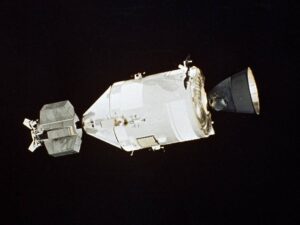 There were other concerns about the ASTP program – the transfer of technology to the Soviets and about missing out on another opportunity to gain more expertise from another Skylab mission were issues that troubled NASA officials and the media. Many had dismissed any technology transfer to the Soviets, claiming the Apollo hardware was already obsolete and soon replaced with state-of-the-art shuttle hardware. However, Chris Kraft had noted that perhaps the real benefit for the Soviets came from understanding NASA’s process and management techniques. He also stated that the Soviets got an in-depth look at building spacecraft and running our program. Other negative sentiment included that after the U.S. accomplished landing on the moon and demonstrated a clear technical superiority, this mission allowed the Soviets to climb back up on the stage as an equal to the U.S. in space power.
There were other concerns about the ASTP program – the transfer of technology to the Soviets and about missing out on another opportunity to gain more expertise from another Skylab mission were issues that troubled NASA officials and the media. Many had dismissed any technology transfer to the Soviets, claiming the Apollo hardware was already obsolete and soon replaced with state-of-the-art shuttle hardware. However, Chris Kraft had noted that perhaps the real benefit for the Soviets came from understanding NASA’s process and management techniques. He also stated that the Soviets got an in-depth look at building spacecraft and running our program. Other negative sentiment included that after the U.S. accomplished landing on the moon and demonstrated a clear technical superiority, this mission allowed the Soviets to climb back up on the stage as an equal to the U.S. in space power.
The ASTP brought out the complexities of the two nations working together. It would take five years of planning for a mission where the two spacecraft would remain docked together for only two days. The mission’s main objective was to test the docking mechanism and the rendezvous of two spacecraft launched from two different locations using two disparate vehicles and spaceflight methodologies. It was a seemingly simple task after Mercury, Gemini, and Apollo, but one that required years of understanding the nuances in detail of each other’s space programs and spacecraft to accomplish.
The Apollo Program Ends with a Near Tragedy
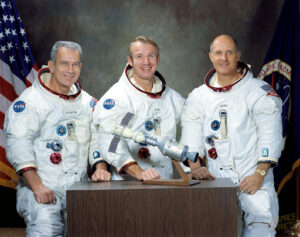 There would be disagreement on whether or not the ASTP was an optimal use of NASA resources. The mission itself was successful but nearly ended in tragedy for the three American astronauts. The crew for the Apollo-Soyuz Test Project was comprised of astronaut Thomas Stafford, the commander of Apollo 10, and a veteran of two Gemini flights, along with first-time flyers Deke Slayton and Vance Brand. Deke Slayton was one of the original Mercury Seven astronauts and the only one of the seven that had not flown. Slayton had been grounded due to a heart condition and had waited fourteen years to get a flight assignment. He would serve as the mission’s Docking Module Pilot. Vance Brand had been with NASA since 1966 and had served as the Apollo 15 backup Command Module Pilot before being assigned that role on the ASTP. It would be this unusual crew mix that would lead to near disaster.
There would be disagreement on whether or not the ASTP was an optimal use of NASA resources. The mission itself was successful but nearly ended in tragedy for the three American astronauts. The crew for the Apollo-Soyuz Test Project was comprised of astronaut Thomas Stafford, the commander of Apollo 10, and a veteran of two Gemini flights, along with first-time flyers Deke Slayton and Vance Brand. Deke Slayton was one of the original Mercury Seven astronauts and the only one of the seven that had not flown. Slayton had been grounded due to a heart condition and had waited fourteen years to get a flight assignment. He would serve as the mission’s Docking Module Pilot. Vance Brand had been with NASA since 1966 and had served as the Apollo 15 backup Command Module Pilot before being assigned that role on the ASTP. It would be this unusual crew mix that would lead to near disaster.
The veteran commander set a chain of events in motion that would bring the space program to the edge of disaster. While the launch, inflight docking, and handshake in space by two rival nations were uneventful. The reentry of the American vehicle was anything but routine. Starting with Apollo 15, the reentry procedures and cockpit automation had been simplified in the Apollo capsule. The change had been done to eliminate the multiple manual step process and reduce the likelihood of a procedural error. Commander Stafford, before the flight, instructed that the old Apollo procedure would be followed. This was not a problem, since, if followed correctly, would have the same result. However, the decision to use the manual process was, in essence, the “backup procedure” should the automation have failed.
Rookie Mistake?
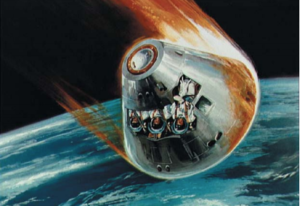 As with most accidents and disasters, the root cause is often a human error. A miscommunication, missed step, or skipped procedure is often the first link in a cascading chain of events. This incident would not be an exception. Under the new automation process, the jettison of the command module’s apex cover, the release of the drogue chutes and parachutes, as well as the shutdown of the reaction control system, and opening of a valve to let external air equalize the internal pressure would be controlled by barometric sensors armed after capsule separation from the service module. The old procedure Commander Stafford had insisted the crew use required a series of switches to be thrown by the Command Module Pilot (CMP) at specific altitudes. The decision to use the outdated Apollo process was driven not by Stafford’s familiarity with the procedure but by a mistrust of the newer technology.
As with most accidents and disasters, the root cause is often a human error. A miscommunication, missed step, or skipped procedure is often the first link in a cascading chain of events. This incident would not be an exception. Under the new automation process, the jettison of the command module’s apex cover, the release of the drogue chutes and parachutes, as well as the shutdown of the reaction control system, and opening of a valve to let external air equalize the internal pressure would be controlled by barometric sensors armed after capsule separation from the service module. The old procedure Commander Stafford had insisted the crew use required a series of switches to be thrown by the Command Module Pilot (CMP) at specific altitudes. The decision to use the outdated Apollo process was driven not by Stafford’s familiarity with the procedure but by a mistrust of the newer technology.
The trouble starts when CMP Vance Brand is twenty seconds late arming the Entry Landing System buses. The switches were supposed to be thrown at 50,000 feet. By the time they were activated, the capsule had fallen to 37,000 feet. At 24,000 feet, Brand notices that the apex cover is still attached, and the drogue chutes had not been deployed. Deke Slayton had called out the command from a checklist, but it was apparent that Brand did not hear him, and execution of the task was never acknowledged. Brand resorts to a backup procedure and manually releases the cover and fires the pyrotechnics to deploy the drogue chutes. All seemed to be on track. At 16,000 feet, Commander Stafford had indicated that he had closed the propellant valves to the reaction control system (RCS). However, although the valve switch was indeed in the off position, the RCS was still activated. The manual procedure required a second switch to be thrown to fully deactivate the RCS. As a result, a reddish-brown fume filled the cabin; it was the toxic nitrogen tetroxide (N2O4). During the late stage of descent into the thickening atmosphere, the closing of the valves without disabling the RCS caused the trapped gas between the tank and the valve to boil. The gas then flooded unabated into the capsule as soon as the cabin pressure relief opened to equalize the interior and exterior pressure. Command Stafford flipped the RCS Command switch to off just as their ship passed through 10,000 feet. At 7,100 feet, with the astronauts falling at 175mph, Command Module Pilot Brand manually deployed the chutes. Deployment occurred well below the 10,000-foot level that was normal for an Apollo spacecraft.
A Near-Death Experience
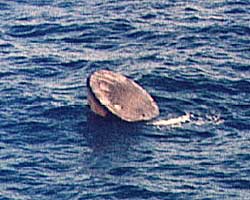 It must have seemed like an eternity, but for thirty-seconds, the toxic gas streamed into the cabin. The astronauts were not in their spacesuits, which would have lessened the impact. The buildup of fumes irritated their skin and eyes, making it difficult to see. Stafford noted that visibility was so impaired by the cloud of fumes that he could not see the dials or his crew. As the toxic gas entered their lungs, the three astronaut’s breathing was compromised. Communication was difficult within the capsule and with Mission Control. For five minutes, the fumes lingered in the cabin. As the Command Module hit the water, it flipped upside down. There were emergency oxygen bottles and masks on board, but they were stowed out of reach for the inverted crew. Commander Stafford released his safety constraints and fell forward, injuring his shoulder. Stafford was able to retrieve the oxygen and provide it to the crew.
It must have seemed like an eternity, but for thirty-seconds, the toxic gas streamed into the cabin. The astronauts were not in their spacesuits, which would have lessened the impact. The buildup of fumes irritated their skin and eyes, making it difficult to see. Stafford noted that visibility was so impaired by the cloud of fumes that he could not see the dials or his crew. As the toxic gas entered their lungs, the three astronaut’s breathing was compromised. Communication was difficult within the capsule and with Mission Control. For five minutes, the fumes lingered in the cabin. As the Command Module hit the water, it flipped upside down. There were emergency oxygen bottles and masks on board, but they were stowed out of reach for the inverted crew. Commander Stafford released his safety constraints and fell forward, injuring his shoulder. Stafford was able to retrieve the oxygen and provide it to the crew.
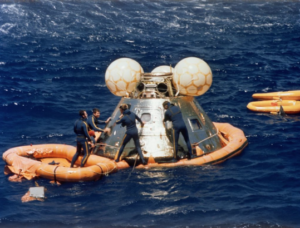 With the Command Module now in an upright position, fresh outside air entering the cabin, and the capsule’s scrubbers working to clear the air, the situation was normalizing. However, Stafford noticed that CMP Brand was unconscious, and his oxygen mask was hanging off the side of his head. The mask was reattached, and with oxygen flowing, Brand regained consciousness. It was estimated he was out for about a minute.
With the Command Module now in an upright position, fresh outside air entering the cabin, and the capsule’s scrubbers working to clear the air, the situation was normalizing. However, Stafford noticed that CMP Brand was unconscious, and his oxygen mask was hanging off the side of his head. The mask was reattached, and with oxygen flowing, Brand regained consciousness. It was estimated he was out for about a minute.
Aftermath
Onboard the recovery ship, the astronauts underwent a post-flight examination. Chief problems noted were itching and burning of the skin and eyes along with burning in the chest with coughing. Stafford had a bruised shoulder from the fall forward inside the inverted capsule. Command Module Pilot Vance Brand had been standing for five minutes during the exam when his systolic blood pressure dropped to 50mm Hg with no diastolic reading. Brand turned pale and complained of weakness. He was seated and was able to recover quickly. Later that evening, the crew was transferred to the ship’s sickbay. The symptoms had not gotten worse, but still, they were coughing and unable to take deep breaths or hold their breath without coughing. The next morning after chest x-rays were taken, Docking Module Pilot Deke Slayton experienced shortness of breath and fainted while brushing his teeth. Slayton’s eyelids were twitching, but there was no evidence of a seizure. He was moved to a sitting position and regained consciousness.
The x-rays showed that the astronauts were suffering from chemical pneumonitis. It was a form of pneumonia brought on by inhaling chemical irritants. In this case, the toxic nitrogen tetroxide. When the recovery ship reached port, the astronauts were transferred to Tripier Army Medical Center in Honolulu, Hawaii, for additional medical care. X-rays taken at the Medical Center showed increased lung irritation, with Deke Slayton showing the most pronounced effects resulting in an adjustment to the crew’s medication. Three days after recovery, they appeared asymptomatic. Six days after recovery, they were discharged with instructions to rest and slowly build their strength and endurance. Eight days later, on August 7, 1975, they were allowed to leave Hawaii and return to their regular duties. A follow-up four weeks later showed no aftereffects from the exposure.
The three astronauts had barely escaped a tragedy. Four years earlier, on June 29, 1971, three Soviet cosmonauts undocked from the Salyut 1 space station. A valve inadvertently opened depressurizing the capsule. Despite efforts to close the valve, the cosmonauts perished and were deceased when the capsule was opened. An accident in the American program would have highlighted the extreme risk during reentry and would have cast a new light on the dangers of human spaceflight and the ability of NASA, or any other space program, to failsafe the equipment and protect the crew. Twenty-eight years later, on February 1, 2003, NASA would lose a crew on reentry as the Space Shuttle Columbia broke apart on its return from space over the skies of Texas.
Unlike the Soviet accident, it was a mix-up in procedures that had left the reaction control system activated due to a key missed switch. There was also conflicting, or at best, ambiguous information on both the Docking Module Pilot and Command Module Pilot’s checklists. Stafford had made it clear before the launch that the backup reentry procedure would be used and the automation bypassed. However, the RCS CMD-OFF, which allowed the toxic gas to enter the cockpit, was not listed on the Command Module Pilot’s checklist as a backup function, but as a primary. The backup commands were omitted from the Docking Module Pilot’s checklist six months before the mission to simplify the instructions. In training, neither the CMP nor DMP had responsibility for flipping the switch. It was strictly a Commander’s function.
Ultimately, the decision not to use the automation that had worked successfully on every mission since Apollo 15 led to confusion with training, checklists, and who was on point for the complicated series of switch throws. The change would prove more problematic with two rookies in critical roles making their first flight.
The exposure to the toxic fumes was potentially life-threatening. Had the three astronauts been rendered unconscious in an inverted position, they likely would not have survived. It was Stafford’s ability to get to the oxygen, provide it to the crew, and right the ship that saved the astronaut’s lives and allowed the gas to vent fully.
Conclusion
It would have been an unfortunate ending to the Apollo program and an auspicious beginning to U.S. – Soviet cooperation if on the last flight of Apollo hardware and the first joint mission between nations that a loss of life would have occurred. Had the astronauts perished, it is likely the cause would have been traced to human error. Still, many conspiracy theorists would have probably blamed sabotage by the Soviets, damage by the Soviet vehicle, a faulty docking mechanism, or what many had thought to be a flawed mission from the start. Such a tragedy could have impacted U.S.-Soviet relations in general and certainly would have affected future cooperation in space.
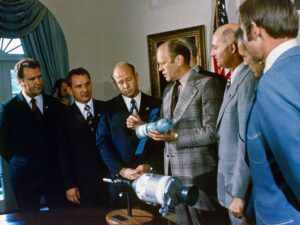 In hindsight, the mission was a technical success but did not immediately lead to further cooperation in space. The symbolism of the mission overshadowed the near-death experience of the crew. Even today, NASA’s website that contains the overview of the Apollo-Soyuz Test Program makes no mention of the near disaster. The mission succeeded in providing the U.S. access to the previously secret Soviet space program. Still, it would take another ten years before another joint mission would occur with the Space Shuttle Atlantis’s first docking with the Mir space station on June 29, 1995. There would be eleven shuttle missions to Mir and one mission with an American astronaut, Norman Thagard, flying aboard a Soviet craft for the first time.
In hindsight, the mission was a technical success but did not immediately lead to further cooperation in space. The symbolism of the mission overshadowed the near-death experience of the crew. Even today, NASA’s website that contains the overview of the Apollo-Soyuz Test Program makes no mention of the near disaster. The mission succeeded in providing the U.S. access to the previously secret Soviet space program. Still, it would take another ten years before another joint mission would occur with the Space Shuttle Atlantis’s first docking with the Mir space station on June 29, 1995. There would be eleven shuttle missions to Mir and one mission with an American astronaut, Norman Thagard, flying aboard a Soviet craft for the first time.
While the ASTP was a valuable public relations success, in the end it benefited the Soviets more than the United States. The Soviets ended us with information related to U.S. thruster technology and retained the docking mechanism and airlock technology. It would take the fall of the Soviet Union and the resulting financial constraints on the Soviets that would finally force their hand in cooperation with the U.S. and would lead to their full partnership in the International Space Station. Eventually, the partnership would take on new meaning. America would become reliant on Soviet hardware to ferry American astronauts and supplies the space station as the space shuttle program went offline due to two tragedies. The ASTP opened the door for two former rivals to show that nations could cooperate on a successful mission. It would take time, and necessity for the program to bear fruit.
Ultimately, as the U.S. program went adrift largely due to the lasting impact of Nixon’s NASA shift from mission objectives to expense control, the former Soviet Union, now Russia, would reemerge as the space power that had managed to maintain a continuous access to space. One could say that aside from the missed objective of a lunar landing, the Russian approach of consistency in hardware with incremental improvements might have won the race after all.
References:
Arnauld E. Nicogossian, M.D. The Apollo-Soyuz Test Project Medical Report, 1977, NASA SP-411.Washington, D.C.: NASA, available from: https://lsda.jsc.nasa.gov/refs/apollo/ASTP_Medical_Report.pdf;
Ezell, Edward Clinton and Linda Neuman Ezell. The Partnership: A History of the Apollo-Soyuz Test Project.Washington, D.C.: NASA SP-4209, 1978, available from: http://www.hq.nasa.gov/office/pao/History/SP-4209/cover.htm
History.com Editors. Soviet cosmonauts perish in reentry disaster. A&E Television Networks, 2020, available from https://www.history.com/this-day-in-history/soviet-cosmonauts-perish-in-reentry-disaster
Lambakis, Steven. On the Edge of Earth: The Future of American Space Power. Kentucky: The University Press of Kentucky, 2001.
Lewis, Carl Maj. U.S.-Soviet Cooperation in Space: A Case Study. Global Security.org, 1989, available from http://www.globalsecurity.org/space/library/report/1989/LCE.htm
Lilley, Steve. Asynchronicity: The Near Loss of the Apollo-Soyuz Test Project Crew, Washington, D.C.:NASA, available from https://nsc.nasa.gov/docs/default-source/system-failure-case-studies/sfcs-2016-07-15-asynchronicity-presentation.pdf?sfvrsn=95a7eff8_2
Loff, Sarah. Apollo-Soyuz Test Project Overview. NASA, available from https://www.nasa.gov/apollo-soyuz/overview
Logsdon, John. Ten Presidents and NASA. Washington, D.C.: NASA, available from http://www.nasa.gov/50th/50th_magazine/10presidents.html
Office of Technology Assessment. U.S.-Soviet Cooperation in Space. Washington, DC: U.S. Congress, Office of Technology Assessment, OTA-TM-STI-27, July 1985, available from http://www.fas.org/ota/reports/9546.pdf
Image Credit: NASA
